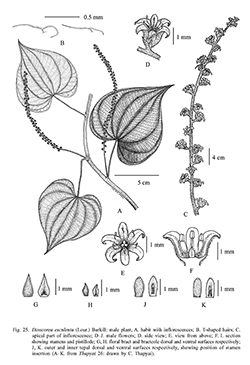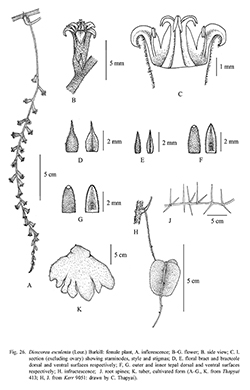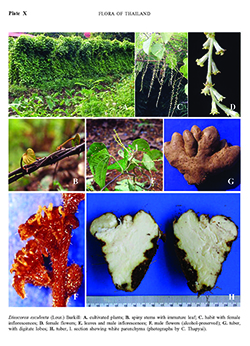e-Flora of Thailand
Volume 10 > Part 1 > Year 2009 > Page 47 > Dioscoreaceae > Dioscorea
13. Dioscorea esculenta (Lour.) Burkillwfo-0000390601
Gard. Bull. Straits Settlem. 1: 371. 1917; R.Knuth in Engl., Pflanzenr. 4, 43: 189. 1924; Prain & Burkill, Bull. Misc. Inform. Kew 1927: 232. 1927; in Fl. Indo-Chine 6: 713. 1934; Ann. Roy. Bot. Gard. (Calcutta) 14(1): 80. 1936; Burkill in Fl. Mal. 4, 3: 307. 1951; Backer, Fl, Jav. 3: 156. 1968; Hô, Câyco Vietnam 3, 2: 935. 1993; Nottie in Fl. Bhutan 3(1): 8. 1994; Jayasuriya in Rev. Handb. Fl. Ceylon 9: 49. 1995; Ding & Gilbert in Fl. China 24: 285. 2000.— Oncus esculentus Lour., Fl. Cochinch. 1: 194. 1790.— Oncorhiza esculenta (Lour.) Pers., Syn. Pl. 1: 374. 1805. Fig. 25, 26; Plate X.
Accepted Name : This is currently accepted.
Synonyms & Citations :
Description : Climber to 10 m. Tubers (1–)2–5(–20), ca 12–15 by 16–20 cm, usually digitate, ovate or globose in cultivated plants, but often cylindric to irregularly lobed in wild forms, annually to perennially replaced, shallowly buried, crown bearing thicker roots and sometimes several rigid thorny roots 26J, especially in wild races). Indumentum of T-shaped hairs present on all parts, stalks 0.05–0.3 mm long, bodies 0.7–2 mm long. Stems 3–12 mm in diam., twining to the left, terete, annual, toward base woody and densely spiny, spines lax on distal stems. Leaves simple, alternate, blade broadly ovate to orbicular, chartaceous, 7–9(–11)-veined, margins entire, base cordate, apex acuminate; petioles 6–14 cm long, terete; lateral nodal spines present, 2.5-6.5 mm long, straight or curved; cataphylls and bulbils absent. Inflorescences pendent, simple, tepals inserted on cup-shaped torus, fused at base; male inflorescences racemose, 1–2 per axil, peduncles 1.7–5 cm long, axes 9.5–25(–50) cm long; flowers solitary, 2.5–4 mm in diam. at anthesis, pedicels 0.8–1.2 mm long; female inflorescences spicate, 1–2(–3) per axil. Male flowers with outer and inner tepals 2.2–2.4 by 0.7–0.9 mm, narrowly oblong, oblong-elliptic or lanceolate to narrowly obovate, stamens 6. Female flowers as in Fig. 26B–G, Pl. 10D. Capsules as in Fig. 26H, ca 26 by 25 mm, very rarely set (only one capsule was seen on Kerr 9051, K sheet). Seeds not seen.
Thailand : NORTHERN: Mae Hong Son (Pai), Chiang Mai (Mae Chem, Doi Suthep Pui, Chang Klan), Lampang (Huai Luang), Phitsanulok (Bankrathum, Nakhon Thai); NORTH EASTERN: Nong Bua Lamphu (Na Wang), Mukdahan; EASTERN: Nakhon Ratchasima (Bua Yai), Ubon Ratchanathani; CENTRAL: Krung Thep Maha Nakhon (Bangkok) (cultivated), Saraburi (Muak Lek); SOUTH EASTERN: Prachin Buri (Khao Singto), Chon Buri (Sri Racha); PENINSULAR: Nakhon Si Thammarat (Lan Saka).
Distribution : A domesticate probably of SE Asian origin, now widely cultivated for its edible tubers across the moister parts of tropical Asia, New Guinea, Madagascar and the Pacific Islands. Type from Vietnam.
Ecology : Open and cultivated areas near current or former human habitation ranging, near sea level to 500 m alt. Cultivated as a food crop, truly "wild” plants probably never encountered. Flowering: June–July; fruiting: probably August–October but capsules very rarely produced in Thailand.
Vernacular : Man chuak (มันจ้วก)(Chiang Mai, Lampang); man aon (มันอ้อน)(Chiang Mai, Phitsanulok); man ka chak/man kra chag (มันกะชาก/มันกระจาก)(Phitsanulok, Saraburi); mui aa (มุยอา)(Nakhon Si Thammarat); man tiak (มันเตียก)(Ubon Ratchathani); man iphoem (มันอีเพิ่ม), man phoem/man i phiam (มันเพิ่ม/มันอีเพียม), man phiam (มันเพียม)(Ubon Ratchathani, Prachin Buri, Northeastern); man mue suea (มันมือเสือ)(Central); man mung (มันมุ้ง)(Chon Buri, Chanthaburi).
Uses: This yam is widely consumed in Thailand, and needs no pre-preparation. The tubers of type a) above are often boiled with salt then eaten with sugar or occasionally with coconut. Due to its popularity, it is available in local or roadside markets. The tubers of type b) are eaten in the same manner but also used to prepare a special dessert. After peeling and cleaning, their tubers are sliced into small cubes then mixed with rice flour and steamed for 30–45 minutes. It is delicious when mixed with sugar and coconut.
Conservation Status: IUCN red list category LC (IUCN 2001), although a survey of races and cultivars is needed to assess whether any need conservation. Undomesticated plants, if found, would also merit conservation.
Notes: This species is easy to identify with its T-shaped hairs, which are usually dense and often give a greyish hue to young leaves and flower buds. The broadly ovate to orbicular leaves are also a useful spot character.
There are two main types of of Dioscorea esculenta encountered in Thailand associated with different vernacular names:
a) Not climbing more than 3 m high, with annually replaced tubers lacking thorny roots. It usually produces lobed or clustered tubers, with of up to 20 per individual and is very widespread in distribution. A common form has a tuber which is ± flattened with irregular lobes resembling a tiger paw, hence the name man mue suea (มันมือเสือ) or tiger paw yam.
b) Climbing to at least 5 m in height, with perennially replaced tubers. The latter type usually produces only one or two large tubers per plant, and has robust stems which are very spiny especially towards the base, and possesses thorny roots to protect the tuber. This type is not as widely distributed as a). The tubers of this form are often globose or short and cylindric with small rootlets outside. It is known as man ka chak/ man kra chag (มันกะชาก/มันกระจาก) in Phitsanulok or man iphoem (มันอีเพิ่ม), man phoem/man iphiam (มันเพิ่ม/มันอีเพียม), man phiam (มันเพียม) in the north-eastern or man tiak (มันเตียก) in Ubon Ratchathani.
However, both types taste very similar and there is no other morphological differentiation between them, so they probably represent no more than cultivars or groups of cultivars with differing degrees of domestication. In Ding & Gilbert (2000) they are treated as var. esculenta and var. spinosa (Roxburgh ex Prain & Burkill) R.Knuth respectively.



